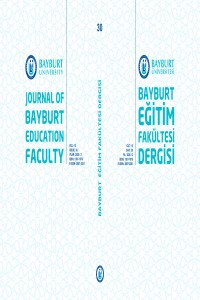Program Görselleştirme Aracıyla Gerçekleştirilen Dijital Öyküleme Etkinliklerinin Yaratıcı Problem Çözme ve Bilgisayar Tutumuna Etkisi
Abstract
Günümüzde üzerinde durulan becerilerden birisi Yaratıcı Problem Çözme becerisidir. Bu beceri Türkiye olarak öğrencilerimizin yoksunluk yaşadığı beceri olarak görülmektedir. Zira PISA 2015 sonuçlarına göre Türkiye, yaratıcı problem çözme becerisi bakımından OECD ülkeleri içerisinde sonuncu sıralardadır. Problem çözme becerisinin düşük olması, bireylerin karşılaştıkları sorunları çözmekte zorlanmalarına sebep olabilmektedir. Birçok araştırmacı için bilgisayar teknolojisi, öğrenme ve öğretmenin yollarını etkin şekilde destekleyen önemli bir araçtır. Bu doğrultuda, öğrencilerin bilgisayara karşı tutumu, bilgisayarı öğrenme aracı olarak kabul etmelerinde önem taşımaktadır. Bireylerin bilgisayara karşı olumlu tutum geliştirmeleri, yaşamlarını kolaylaştıracağı gibi, oldukça önemli becerileri edinmelerini de kolaylaştıracaktır. Bu araştırmada Program Görselleştirme Aracı (Scratch) ile gerçekleştirilen dijital öyküleme etkinliklerinin öğrencilerin yaratıcı problem çözme becerisine (YPÇB) ve bilgisayara yönelik tutumlarına olan etkisi incelenmiştir. Çalışmada açıklayıcı desen tercih edilmiş; uygun/ kolay ulaşılabilir örneklem seçilerek toplamda 61 katılımcıyla çalışma yürütülmüştür. Uygulanan programın öğrencilerin yaratıcı problem çözme becerisi ve bilgisayara yönelik tutumları üzerindeki kritik boyutlarda anlamlı bir farklılaşma sağladığı tespit edilmiştir.
References
- Altman, D. G. (1990). Practical statistics for medical research. CRC press.
- Akyuz, S., & Yavuz, F. (2015). Digital learning in EFL classrooms. Procedia-Social and Behavioral Sciences, 197, 766-769. Baran-Bulut, D., İpek, A. S., & Aygün, B. (2018). Yaratıcı problem çözme özellikleri envanterini Türkçeye uyarlama çalışması. Abant İzzet Baysal Üniversitesi Eğitim Fakültesi Dergisi, 18(3), 1360-1377.
- Chanayotha, P., & Na-songkhla, J. (2015). Development of the open educational rajabhat university students resources using service learning to enhance public consciousness and creative problem solving. Procedia-Social anfiçerid Behavioral Sciences, 174, 1976-1982.
- Demir, Ö., & Yurdugül, H. (2014). Ortaokul ve lise öğrencileri için bilgisayara yönelik tutum ölçeğinin Türkçe’ye uyarlanması. Eğitim ve Bilim, 39(176).
- Dumas, D., Schmidt, L. C., & Alexander, P. A. (2016). Predicting creative problem solving in engineering design. Thinking Skills and Creativity, 21, 50-66.
- Lin, C. (2010). Analyses of attribute patterns of creative problem solving ability among upper elementary students in Taiwan. Unpublished document, St. John's Unıversıty, New York.
- Nelson, J. (2009). Celebrating scratch in libraries: creation software helps young people develop 21st-century literacy skills. School Library Journal, 20–21.
- OECD (2017), PISA 2015 results (volume v): collaborative problem solving, PISA, OECD Publishing, Paris.
- Ouahbi, I., Kaddari, F., Darhmaoui, H., Elachqar, A., & Lahmine, S. (2015). Learning basic programming concepts by creating games with scratch programming environment. Procedia-Social and Behavioral Sciences, 191, 1479-1482.
- Pemberton, J. R., Borrego, J., & Cohen, L. M. (2006). Using interactive computer technology to enhance learning. Teaching of Psychology, 33(2), 145-147.
- Phaksunchai, M., Kaemkate, W., & Wongwanich, S. (2014). Research and development of a training package for developing creative problem solving of undergraduate students. Procedia-Social and Behavioral Sciences, 116, 4824-4828.
- Prensky, M. (2001). Digital natives, digital immigrants part 1. On the horizon, 9(5), 1-6.
- Revathi, A & M, Shwettha. (2019). Digital learning. CSI Communication. 21-23.
- Robin, B. R. (2015). The effective uses of digital storytelling as a teaching and learning tool. Handbook of research on teaching literacy through the communicative and visual arts, 2, 429-440.
- Sáez-López, J. M., Román-González, M., & Vázquez-Cano, E. (2016). Visual programming languages integrated across the curriculum in elementary school: A two year case study using “Scratch” in five schools. Computers & Education, 97, 129-141.
- Sadik, A. (2008). Digital storytelling: A meaningful technology-integrated approach for engaged student learning. Educational technology research and development, 56(4), 487-506.
- Sylla, C., Coutinho, C., Branco, P., & Müller, W. (2015). Investigating the use of digital manipulatives for storytelling in pre-school. International Journal of Child-Computer Interaction, 6, 39-48.
- Teo, T. (2006). Attitudes toward computers: A study of post-secondary students in Singapore. Interactive Learning Environments, 14(1), 17-24.
- Teo, T. (2008). Assessing the computer attitudes of students: An Asian perspective. Computers in Human Behavior, 24, 1634-1642.
- Vickers, A. J. (2005). Parametric versus non-parametric statistics in the analysis of randomized trials with non-normally distributed data. BMC medical research methodology, 5(1), 35.
Details
| Primary Language | Turkish |
|---|---|
| Subjects | Other Fields of Education |
| Journal Section | Research Article |
| Authors | |
| Publication Date | December 31, 2020 |
| Submission Date | July 29, 2020 |
| Acceptance Date | November 9, 2020 |
| Published in Issue | Year 2020 Volume: 15 Issue: 30 |

